Yuca con mojo: tender, creamy cassava, drizzled with a citrus garlic sauce (mojo), is one of the most traditional dishes of Cuban food. It’s consumed as a side dish, although many like to eat it as a main dish.
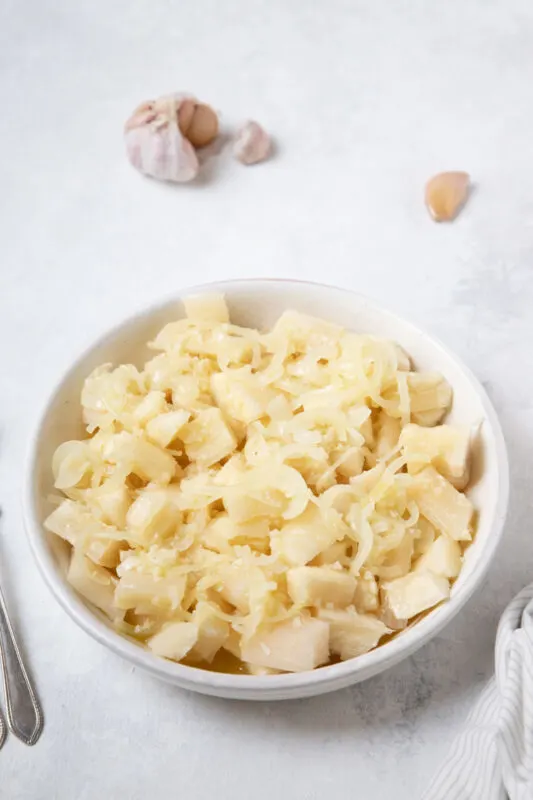
Yuca (or cassava) is an inexpensive crop, and its consumption has spread throughout the world. There are countless dishes that feature cassava (like Colombian cassava cheese bread, Paraguayan cheese flatbread, and Bolivian cassava beef fritters).
But most Cubans will choose, without a doubt, yuca with mojo.
This dish is enjoyed in Puerto Rico, Dominican Republic, and Cuba. Each one of them giving the dish a slight variation.
What is mojo?
Mojo is one of Cubans favorite sauces to use to season their dishes.
There are two kinds of mojo sauce: cooked and fresh.
Cooked mojo uses fat (oil or lard), sour oranges, salt, and garlic. This mojo is used to pour and flavor tostones (fried plantain), French fries, rice, and cassava.
Fresh mojo uses oil, sour oranges, garlic, and different spices, making it great for marinating different types of meat.
Both sauces are made with sour oranges and lots of garlic.
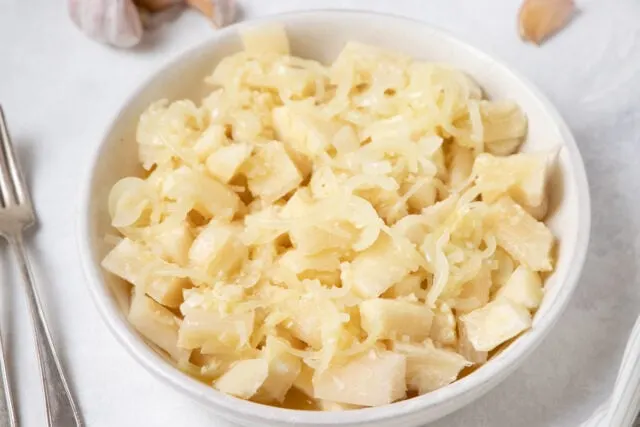
Is there a substitute for sour orange?
Sour oranges tend to be large and juicy. They have a rough-surfaced, with a thick, aromatic, bitter peel. The pulp has a bitter flavor due to the higher acid content of the fruit.
Many cooks, even the ones living in Cuba, replace sour orange with two parts regular orange juice, one part lemon juice, and one part lime juice.
Cassava or yuca?
Manihot Esculenta is the scientific name for what is commonly called cassava or yuca. This root is part of the basic diet in tropical countries, and as such it is often the main ingredient in many dishes.
This food contains a large number of carbohydrates in the form of starch and is low in fat. It’s great for satisfying hunger and provides a large amount of energy.
From this root, you can get cassava flour or cassava starch and make different kinds of gluten-free bread like Paraguayan chipa or Ecuadorian cassava bread.
This tuber goes from a starchy root to a creamy, mild-tasting veggie once boiled. Mash it with some salt and cheese and you can make this Bolivian Cassava Casserole.
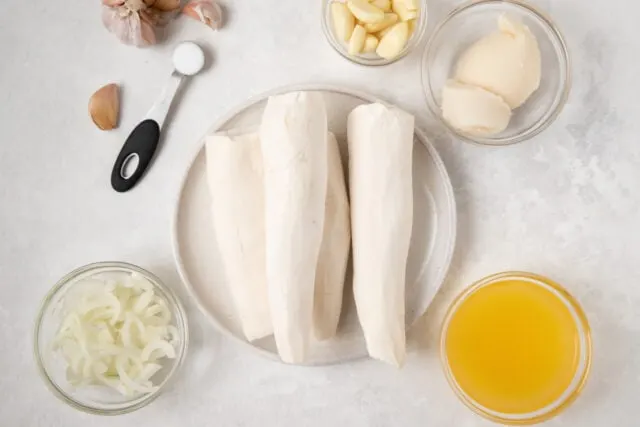
For this recipe, I used frozen cassava. It comes already chopped and peeled. It tastes the same and has the same consistency as fresh cassava.
In the US, fresh cassava comes with a thick layer of wax that protects it from bruises. But, this makes it harder to check for freshness.
If you live near a Latino community, frozen and fresh cassava will be easily available at your local Latin grocer.
How to peel fresh cassava
To peel fresh cassava, use a paring knife. First, cut the top off of the root. The bark (outer skin) is not as hard as the inner white part , so if you insert the knife between the pinkish bark and the white part, there is no need to cut. Simply slide the knife between these parts. It peels very easily.
Once peeled, place them in water quickly, to avoid discoloration.
When cooking fresh cassava you can expect it to take between 10 and 30 minutes. Many people like to use a pressure cooker. But I’ve noticed that cassava in the US (fresh or frozen), once the water boils, is done between 8 to 10 minutes. Just keep an eye on it once it starts boiling.
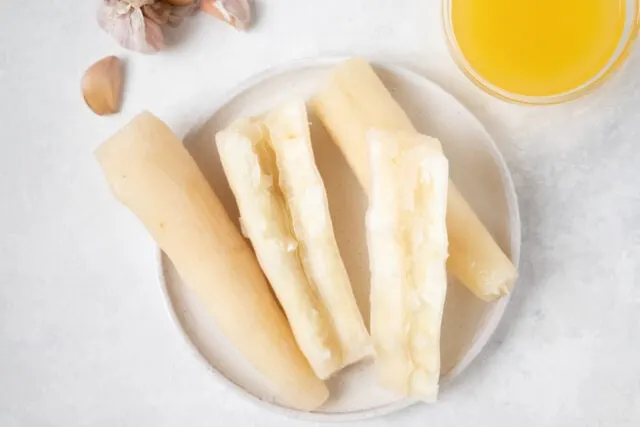
How to make cooked Cuban mojo
Once the cassava is done cooking, cut it into chunks and place them in a serving bowl. The next steps are done pretty quickly.
You’ll need a saucepan with a lid. Heat lard or vegetable oil until very hot. If using onions, cook them just for a few seconds, and then pour in the remaining mojo ingredients. Quickly, cover it with the lid and turn off the heat.
The onions and garlic will cook enough to lose their raw bite and add flavor to the mojo, but they won’t burn.
Pour this hot mojo over the cassava, and serve.
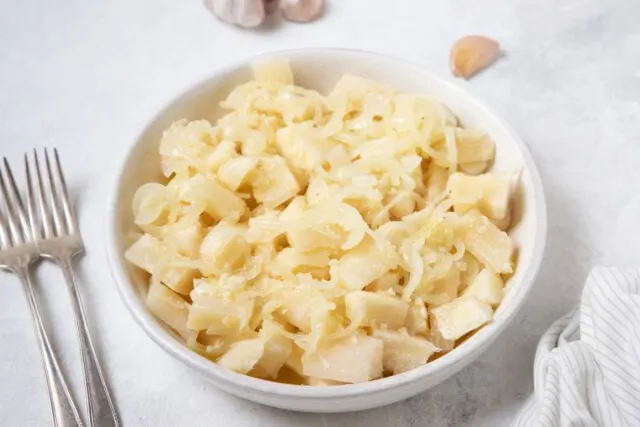
Cuban Yuca con Mojo
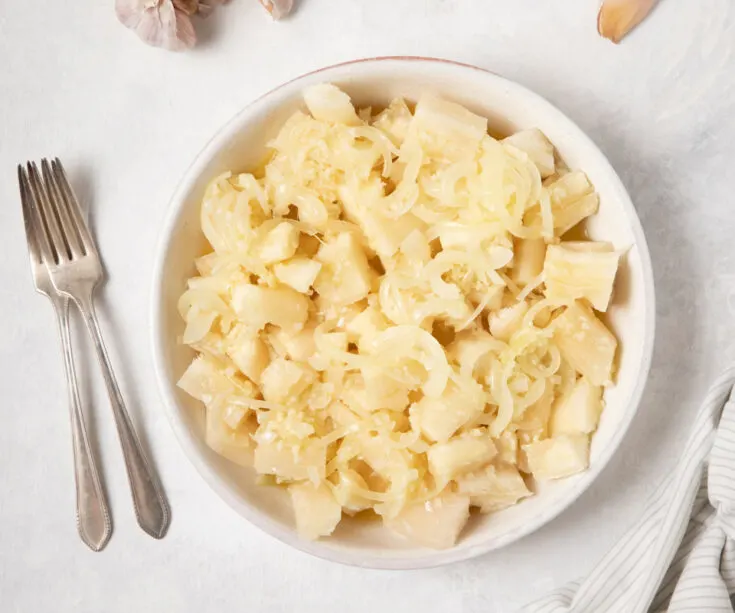
Yuca con mojo is a side dish of tender, creamy cassava, drizzled with a citrus garlic sauce (mojo). It is one of the most traditional dishes of Cuban food.
Ingredients
- 1 pound Cassava, frozen
- 6 garlic cloves, peeled
- 1/2 teaspoon salt
- 6 Tablespoons sour orange juice*
- 1/4 cup lard or vegetable oil
- 1/2 small onion, sliced
Instructions
- Add frozen cassava to a large pot, cover with water, and bring to a boil over high heat. Cook for 8 minutes and check for doneness. (Prick with a fork and it should be soft, but firm.) Drain the water and cut cassava in chunks of 1 to 2 inches.
- Make a paste with the garlic and the salt using a small food processor, or a mortar and pestle.
- Mix the garlic and salt paste with the sour orange juice.
- In a small saucepan with a lid, heat the lard or vegetable oil on high. Once it is hot, add the onions and let them cook for about 20 seconds. Add the sour orange juice mixture, close the lid, and turn off the heat. Let stand for a few seconds.
- Arrange cassava chunks on the serving platter, drizzle the hot mojo over the cassava, and serve.
Notes
*If you don't have sour orange juice you can substitute 4 Tbsp regular orange juice + 1 Tbsp lemon juice + 1 Tbsp lime juice.
Nutrition Information:
Yield:
5Serving Size:
1/5 of recipeAmount Per Serving: Calories: 278
If you liked this recipe, here are some similar dishes you may enjoy!

Lizet is Bolivian and lives in Paraguay. Through friends and travel she has developed her love of food. From Africa to Asia, Europe to the Americas, there is always something new to try when you come to dinner. You can find more of Lizet’s tasty creations on her website ChipaByTheDozen.com. You can also find her on Instagram and Facebook.



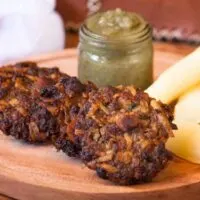

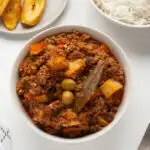
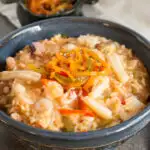

Gabe B.
Monday 8th of November 2021
As a Cuban, I can tell you that you forgot to include a (most important) step when cooking yuca. You definitely need to shock it in order to obtain a very tender texture. Once the water has boiled and the yuca splits in half, you throw away the hot water. Then, you'll replace it with cold faucet water, thus continue to cook it for additional tenderness. In my home, when the yuca is almost ready, we get a separate sauce pan, cut a white onion and sautee it in olive oil. In addition, after a few minutes we add a few sliced garlic heads (don't brown it), salt (and pepper, if desired). When the yuca is soft enough, we drain the water, add the hot mojo and then squeeze a large sour orange over it. Good luck if any leftovers are left for the next day.
Sarah Ozimek
Tuesday 9th of November 2021
Thank you for sharing this tip Gabe!